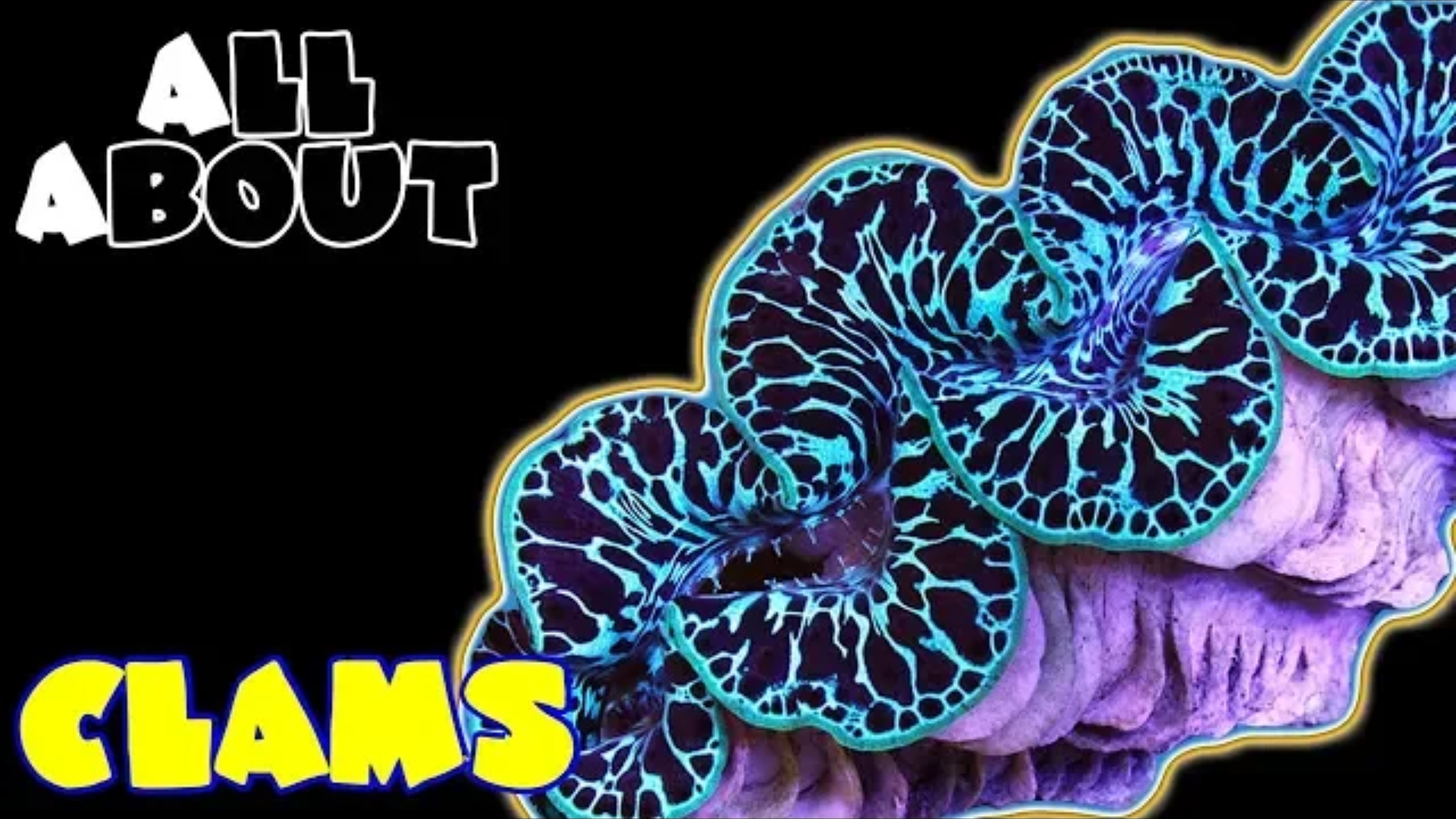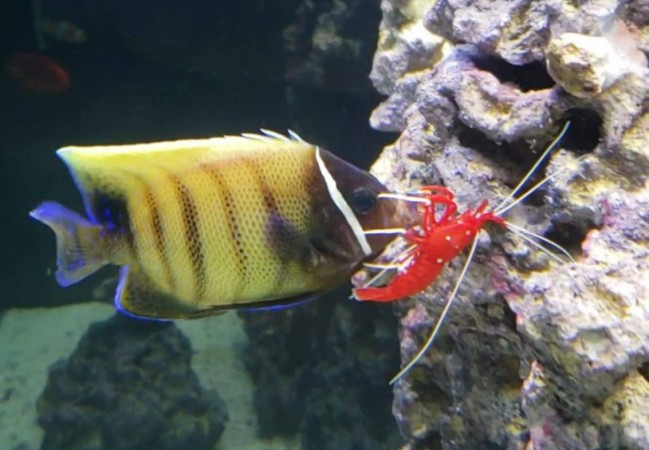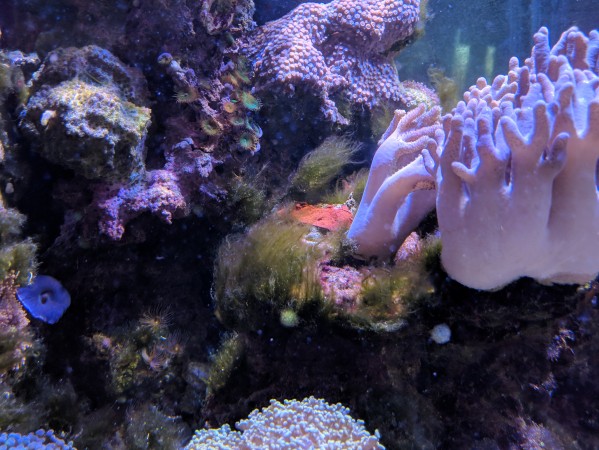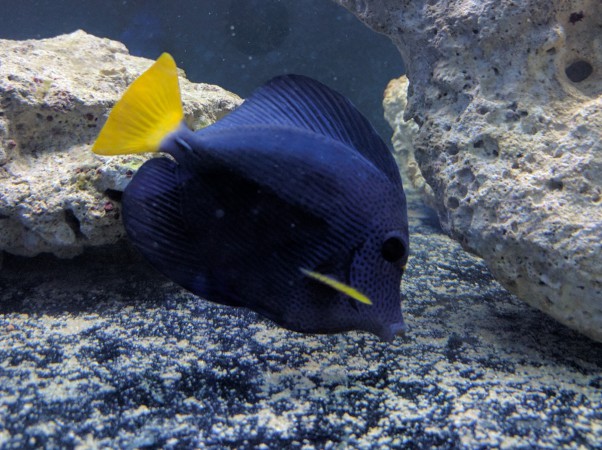- Name:
Freshwater Asian Gold Clam
- Family: Unionidae
- Species: Clam
- Scientific Name: Pilsbryoconcha exilis
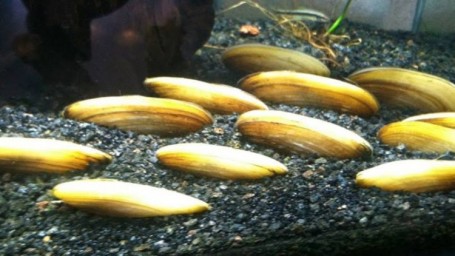

General info about Freshwater Asian Gold Clam
The Freshwater Asian Gold Clam offers a great choice for hobbyists seeking the unusual and also efficient filter feeder. They can help keep aquarium water clear and clean and this will result for a balanced eco-system in the tank. Unlike many freshwater bivalves, that completely bury themselves in the substrate, the Freshwater Asian Gold Clam prefers to remain only partially buried. As a result, the Freshwater Asian Gold Clam is much easier to observe and appreciate. The Freshwater Asian Gold Clam is a filter feeder that
An Asian Gold Clam is generally gold, light brown or tan in color. Their shells are oblong in shape compared to other more round freshwater clams. Their shells have a grooved texture resulting from their growth rings. An Asian Gold Clam has an inhalant siphon and an exhalant siphon used to move water in and out for feeding and respiration. Both siphons have filament-like appendages surrounding their perimeter. The appendages are sensitive to touch. An Asian Gold Clam also has a large powerful white foot used to move throughout the tank. Interestingly, the Freshwater Asian Gold Clam is often quite active at night when you may be able to witness it using its "foot" to lumber across the aquarium bottom.
A healthy Asian Gold Clam can grow quite large given proper tank conditions. In stores, Asian Gold Clams generally average between 3 and 3 1/2 inches in length. Its said in some cases, under the right conditions, Asian Gold Clams can grow to be about 8 inches in length. An Asian Gold Clam can live a year or so in good conditions. Some hobbyist says they’ve had luck with clams living upwards of three years. Other hobbyists have had clams last about three or four months, and some die shortly after being introduced to a new tank. Its really hard to say much for sure regarding a clam’s lifespan, because a lot has to do with water conditions, the clam itself, and plain luck. It is a good idea to hope for about one year, and if the clam lives longer, its a bonus.
It is important to make sure the clam is being kept in a filtered, completely cycled and fully established tank. Make sure water parameters stay stable within a healthy range. It is also important to make sure there is sufficient edible matter in the water column to support the clam’s nutritional needs. Finally, make sure the water current is moving quickly enough to keep sufficient edible matter floating throughout. A filter-feeding Asian Gold Clam needs to be in a tank with sufficient size and capacity to support its life. A 10-gallon tank is too small. While some hobbyists suggest that a 15-gallon tank is sufficient for one Asian Gold Clam, the better choice is to keep it in a tank that is 29 gallons, and up. The tank should have plenty of fine substrate on the tank bottom. The substrate should be deep enough for the clam to burrow. 7.0 to 8.0 pH is necessary to avoid shell erosion. For water temperature 70 – 85 Degrees Fahrenheit and also slightly cooler is possible. The water should be on the hard side and standard community tank lighting can be used.
An Asian Gold Clam can be kept in tanks with lots of live plants. Shedding plants can create a constant supply of edible debris for clams to eat. But with Asian Gold Clams and live plants, be prepared for a clam to inadvertently uproot a plant now and then as it borrows under the substrate.
The Gold Asian Clam is fairly adaptable as long as sudden changes in water parameters/quality are avoided. It must be placed in an area of high water flow in the aquarium. As with most clams and mussels, it should not be exposed to air and it ideally should not be disturbed once placed and established in the aquarium.
The Freshwater Asian Gold Clam should not be housed with large aggressive or carnivorous fish as well as invertebrate-eating fish, such as freshwater puffers. If Asian Gold Clams are being kept in a community tank, most peaceful community tank fish should work, with Cory Catfish and Otocinclus Catfish being particularly safe choices. Just make sure the tank is not overstocked. Avoid keeping Asian Gold Clams with tougher species such as Cichlids, Goldfish and aquarium crayfish. These can harm or kill clams.
Freshwater Asian Gold Clam Diet & Nutrition
An Asian Gold Clam should be able to meet its nutritional needs by siphoning established tank water; filtering food and detritus from the water column. This is especially true in well-planted tanks containing otherwise well-fed inhabitants. But even if the tank seems able to support the nutritional needs of an Asian Gold Clam, it may be a good idea to offer pinches of Calcium rich, commercial food supplements on occasion. Food supplements should be finely ground fish flakes, bottom feeder tablets, fish pellets, algae wafers, or other invertebrate food.
By removing uneaten food and detritus from the water column, the Freshwater Asian Gold Clam helps maintain water quality and lower nitrate levels.
Determining Sex of Freshwater Asian Gold Clam
They are hermaphrodites.
Breeding & Spawning Freshwater Asian Gold Clam
Adult Golden clams are simultaneous hermaphrodites (both male and female) that are capable of both cross and self-fertilization, so, it takes only 1 individual clam to start a population. Adults can live 3-4 years, and typically reproduce two times a year, although they may reproduce more often under optimal situations. A single adult can produce 1000-100,000 juveniles per year. Egg fertilization is internal and the larval clams are brooded on the qill where they transform into juveniles in about 4-5 days. Juvenile clams can reach maturity in 3-6 months.
Freshwater Asian Gold Clam Origin
They come from East Asia and the Philippines.
Caution with Freshwater Asian Gold Clam
When buying an Asian Gold Clam, look for clams that are resting on the tank bottom. exhalant clamshell should be free from cracks, pits, extensive erosion, or other deformities. Shell damage may be an indication the clam has been in less than ideal water conditions for long periods of time. The clamshell should be either closed or slightly open with their siphons and soft tissue slightly visible. Since Asian Gold Clams are slow moving and live on the tank bottom, it is not uncommon for shells to be partially covered with patches of green algae or fibrous green plant matter. Avoid buying Asian Gold Clams if they floating, if their shells are open more than a crack, or if the interior of the clam can be seen. These can be indications the clam is dead or dying. Finally, make sure the closed shell is not empty. It is not uncommon for closed, empty clam shells to be accidentally sold as being alive. An empty clam shell will feel very light, and water will pour from it when it is removed from a tank.
Ammonia and Nitrites should be kept at 0 ppm. Nitrate levels should be kept low with regular partial water changes. Also, be careful with additives. Medications and plant fertilizers may contain substances harmful to clams. This is particularity true with Copper. Keep in mind that the Freshwater Asian Gold Clam will not tolerate any copper-based medication. If treating the aquarium with medication containing copper, move the Freshwater Asian Gold Clam to another aquarium. Do not return the Freshwater Asian Gold Clam until the copper in the treated aquarium has been removed by means of chemical filtration.
It is very important to keep an eye out for dead clams. Remove a dead clam from a tank immediately. Decomposing clams can destroy tank water quality very quickly. Water can turn cloudy white and ammonia levels can shoot up, causing harm or death to other inhabitants. This especially important if the clam dies while buried. A dead buried clam may not be discovered until the water damage is done.
Acclimating Freshwater Asian Gold Clam
Once you first get delivery of your clams, acclimate like you would a fish by floating the clam bag in your aquarium or pond, then slowly add some of your water to the bag, no need to take a long time to do this, perhaps less than 5 minutes, then just dump the bag into your tank.
Original Detail
| Name | Species | Family | Scientific Name | More Detail | Added by |
|---|---|---|---|---|---|
| Freshwater Asian Gold Clam | Clam | Unionidae | Pilsbryoconcha exilis | The Freshwater Asian Gold Clam offers a great choice for hobbyists seeking the unusual and also efficient filter feeder. They can help keep aquarium water clear and clean and this will result for a balanced eco-system in the tank. Unlike many freshwater bivalves, that completely bury themselves in the substrate, the Freshwater Asian Gold Clam prefers to remain only partially buried. As a result, the Freshwater Asian Gold Clam is much easier to observe and appreciate. The Freshwater Asian Gold Clam is a filter feeder that An Asian Gold Clam is generally gold, light brown or tan in color. Their shells are oblong in shape compared to other more round freshwater clams. Their shells have a grooved texture resulting from their growth rings. An Asian Gold Clam has an inhalant siphon and an exhalant siphon used to move water in and out for feeding and respiration. Both siphons have filament-like appendages surrounding their perimeter. The appendages are sensitive to touch. An Asian Gold Clam also has a large powerful white foot used to move throughout the tank. Interestingly, the Freshwater Asian Gold Clam is often quite active at night when you may be able to witness it using its "foot" to lumber across the aquarium bottom. A healthy Asian Gold Clam can grow quite large given proper tank conditions. In stores, Asian Gold Clams generally average between 3 and 3 1/2 inches in length. Its said in some cases, under the right conditions, Asian Gold Clams can grow to be about 8 inches in length. An Asian Gold Clam can live a year or so in good conditions. Some hobbyist says they’ve had luck with clams living upwards of three years. Other hobbyists have had clams last about three or four months, and some die shortly after being introduced to a new tank. Its really hard to say much for sure regarding a clam’s lifespan, because a lot has to do with water conditions, the clam itself, and plain luck. It is a good idea to hope for about one year, and if the clam lives longer, its a bonus. It is important to make sure the clam is being kept in a filtered, completely cycled and fully established tank. Make sure water parameters stay stable within a healthy range. It is also important to make sure there is sufficient edible matter in the water column to support the clam’s nutritional needs. Finally, make sure the water current is moving quickly enough to keep sufficient edible matter floating throughout. A filter-feeding Asian Gold Clam needs to be in a tank with sufficient size and capacity to support its life. A 10-gallon tank is too small. While some hobbyists suggest that a 15-gallon tank is sufficient for one Asian Gold Clam, the better choice is to keep it in a tank that is 29 gallons, and up. The tank should have plenty of fine substrate on the tank bottom. The substrate should be deep enough for the clam to burrow. 7.0 to 8.0 pH is necessary to avoid shell erosion. For water temperature 70 – 85 Degrees Fahrenheit and also slightly cooler is possible. The water should be on the hard side and standard community tank lighting can be used. An Asian Gold Clam can be kept in tanks with lots of live plants. Shedding plants can create a constant supply of edible debris for clams to eat. But with Asian Gold Clams and live plants, be prepared for a clam to inadvertently uproot a plant now and then as it borrows under the substrate. The Gold Asian Clam is fairly adaptable as long as sudden changes in water parameters/quality are avoided. It must be placed in an area of high water flow in the aquarium. As with most clams and mussels, it should not be exposed to air and it ideally should not be disturbed once placed and established in the aquarium. The Freshwater Asian Gold Clam should not be housed with large aggressive or carnivorous fish as well as invertebrate-eating fish, such as freshwater puffers. If Asian Gold Clams are being kept in a community tank, most peaceful community tank fish should work, with Cory Catfish and Otocinclus Catfish being particularly safe choices. Just make sure the tank is not overstocked. Avoid keeping Asian Gold Clams with tougher species such as Cichlids, Goldfish and aquarium crayfish. These can harm or kill clams. |
PalaciosAn |
Changed by users
| Submitted Date | Submitted By | Status | Action |
|---|


